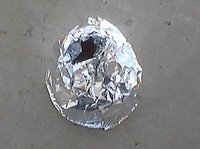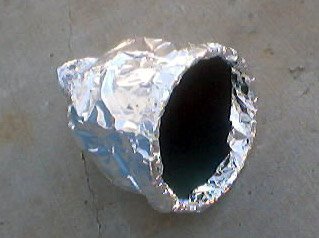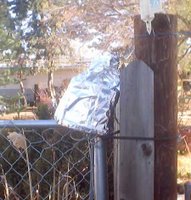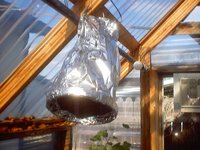The Greenhouse.
 The Greenhouse is 8 wide, a bit less then 10 feet long and 9 feet tall at the peak. The roof starts at the 5 foot mark which makes for a steep pitch.
The Greenhouse is 8 wide, a bit less then 10 feet long and 9 feet tall at the peak. The roof starts at the 5 foot mark which makes for a steep pitch.I was delighted when my realtor informed us that the property included a greenhouse. What she failed to say that it had seen better days. It was covered with sun scorched PVC punched full of holes by a nasty hailstorm. We bought the place anyway, and the greenhouse has become another project.
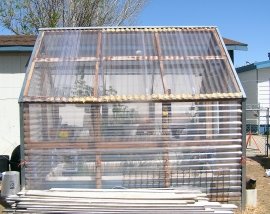 Tucked up in the garage rafters I found enough PVC material (PALRUF) to cover the badly dammaged south side of the roof. I am in the process of patching the remaining holes. A patch is cut to cover the hole and glued in place with clear silcone. There is no hurry to finish the work in that the danger of frost has past and the holes provide additional venting. Which is a great segway to the next topic.
Tucked up in the garage rafters I found enough PVC material (PALRUF) to cover the badly dammaged south side of the roof. I am in the process of patching the remaining holes. A patch is cut to cover the hole and glued in place with clear silcone. There is no hurry to finish the work in that the danger of frost has past and the holes provide additional venting. Which is a great segway to the next topic.I would like to keep the greenhouse running most of the year. Our area gets frequent wind and some hail. Keeping a few pond plants in the greenhouse would protect them from the weather.

In the summer that requires cooling. Currently I open the door in the AM and close it at dusk. A small fan hangs in the doorway and is controled by computer. There are also 2 SMALL vents under the peak of the roof on each end. It could be better.
The first upgarde will be shade cloth. Charley's Greenhouse and Garden has online help for building a shade cloth setup that rolls up when not needed. You can find the PDF for the 'general idea' here.
For Active cooling I am thinking about building a evaporative or swamp cooler into part of the far wall. Perhaps automate the vents to open when cooling starts. As a last resort a mister could be used, but the water has a high mineral contentent. If it did not plug the mister it would coat everything in white/gray gunk.
The most expensive upgrade will be the replacement of the PVC with double wall polycarbonate. The current structure goes down to outside air temperature at night. If the unit was tighter and had some R value the pond would help moderate the temperature.
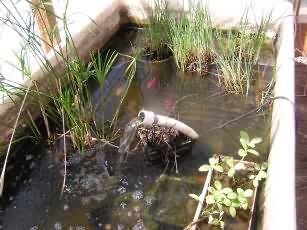


Originaly the greenhouse had two benches to hold pots. One was removed to make roof for this pond aka horse tank.
April 19, 2006
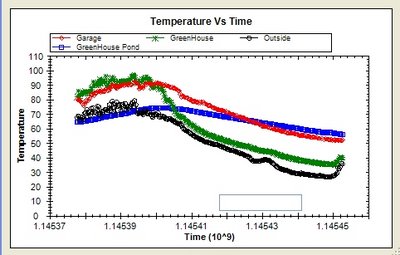 After a week with the lows above 50 it frooze last night. I found a bit of ice this AM. The outdoor sensor's low was 26.8F. The pond air temp got down to 35.7F. The 9 degree diff was enough to keep the plants in the greeenhouse safe. We covered the outdoor strawberry bed that my SO planted last weekend.
After a week with the lows above 50 it frooze last night. I found a bit of ice this AM. The outdoor sensor's low was 26.8F. The pond air temp got down to 35.7F. The 9 degree diff was enough to keep the plants in the greeenhouse safe. We covered the outdoor strawberry bed that my SO planted last weekend.
